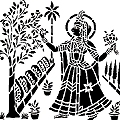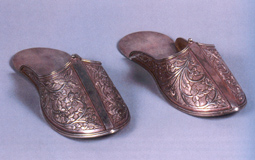Sanjhi- the hand-cutting of paper for ritualistic and ceremonial rangolis - is commonly understood in its contemporary form as a ritualistic craft used in temples, and sometimes homes, for the worship of Lord Krishna. It is believed to have originated, according to the thesis forwarded by Asimakrishna Dasa, in his book "Evening Blossoms: The Temple Tradition of Sanjhi in Vrindavana", as 'a ritual worship undertaken by unmarried girls all over northern India to obtain a suitable husband'. Thus, while the temple craft is practised only by male priests and their male apprentices, the folk aspect of the craft was, and is, practised chiefly by unmarried girls.
This craft, which involves the cutting of an intricate stencil depicting scenes from the life of Lord Krishna and the use of this paper stencil in creating a rangoli or floor decoration, became a temple tradition (according to Dasa) in the 17th century, 'when the devotional bhakti movement linked it to games played by Radha and the Hindu god, Krishna. While the ritual of sanjhi, in its devotional and decorative aspects, continues in villages and homes in north India, the temple tradition seems to have become confined to three important temples at Vrindavana and a single temple at Barsana, Radha's village.
It is important to remember that all sanjhis, whether a part of the folk tradition or of the temple tradition, are made to be worshipped. According to Dasa: "At the time of worship they are transformed from works of art fashioned by human beings into a divine being, Goddess Sanjhi... the transformation fro...
This is a preview. To access all the essays on the Global InCH Journal a modest subscription cost is being levied to cover costs of hosting, editing, peer reviewing etc. To subscribe, Click Here.
ALSO SEE
The Tradition of Foot Covering in Indian Cultur...
Pathak, Anamika
Framing the Fluid Multiple Perspectives on Bhar...
Johar, Navtej




